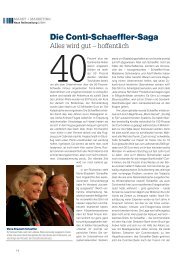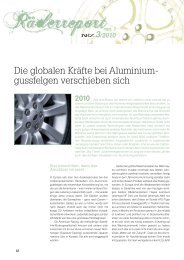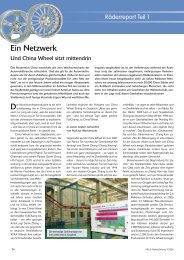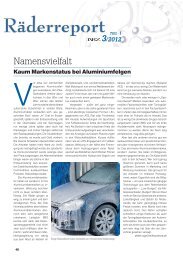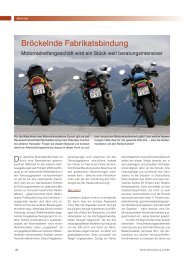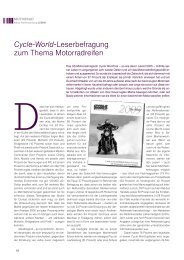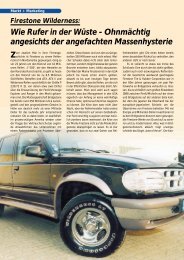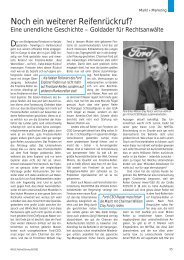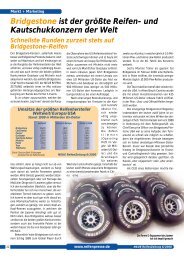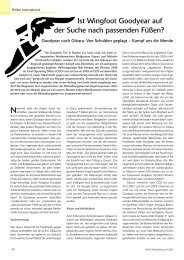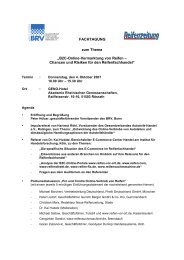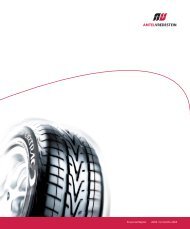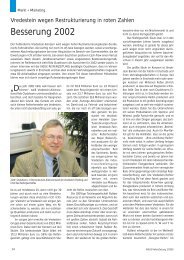Layout 1 (Page 1) - Reifenpresse.de
Layout 1 (Page 1) - Reifenpresse.de
Layout 1 (Page 1) - Reifenpresse.de
Erfolgreiche ePaper selbst erstellen
Machen Sie aus Ihren PDF Publikationen ein blätterbares Flipbook mit unserer einzigartigen Google optimierten e-Paper Software.
sentatives from the member associations unanimously voted to<br />
chose option three, an industry adapted way of attaining the<br />
“Sound” mark for retrea<strong>de</strong>d truck tyres.<br />
Further proceedings<br />
After the general assembly, BIPAVER was in a position to explain all<br />
further proceedings to its members and possible steps that now<br />
were to be taken:<br />
1. In or<strong>de</strong>r to guarantee an overall acceptance of the general assembly’s<br />
<strong>de</strong>cision, BIPAVER is emphasising the importance of working<br />
in conjunction with the ETRMA and the ETRTO. This is important as<br />
in the end it is the new tyre manufacturers, who are strongly<br />
involved in the legislatory processes in Geneva, that are becoming<br />
ever more active in the field of retreading. Thus, closing ranks with<br />
the above-mentioned organisations is surely an appropriate and<br />
useful step.<br />
2. Areas such as technology, the environment and competition all<br />
have to be “worked on” in Brussels in or<strong>de</strong>r to increasingly move<br />
the issue of retrea<strong>de</strong>d tyres into the spotlight and to call attention<br />
to the economic and ecological relevance of retreading.<br />
3. Based on a study presented in September 2003 by Germany’s<br />
BAST (Fe<strong>de</strong>ral Highway Research Institute) with regards to truck<br />
tyre noise emissions, serveral options are available:<br />
A. The basic results of that study are accepted; namely: retrea<strong>de</strong>d<br />
tyres do not generate more noise than comparable new tyres, the<br />
major influencing factor for noise is the tread pattern (negative<br />
pattern ratio, tread <strong>de</strong>pth, tread width) and the abrasiveness of the<br />
tread rubber compound, and other influencing factors including<br />
casing, un<strong>de</strong>rtread rubber, buffing radius only play a secondary<br />
role in the production of noise emissions.<br />
I. The UNECE expands the validity of the noise regulation to inclu<strong>de</strong><br />
retrea<strong>de</strong>d tyres without the necessity for additional tests.<br />
II. An industry adapted method for testing and certifying of retrea<strong>de</strong>d<br />
tyres is expected.<br />
B. The basic results of the BAST study are not accepted as well<br />
foun<strong>de</strong>d and representative. In this case the retreading industry<br />
needs to apply for EU subsidies to accomplish a new study, which<br />
should then be performed as a matter of urgency. It should be said<br />
that this option will most likely be necessary to tackle the issue of<br />
rolling resistance because this issue inclu<strong>de</strong>s many more complex<br />
influencing factors when the tyres in question are retreads.<br />
Should the legislatory bodies chose option A II, BIPAVER would<br />
be in a position to present an elaborate blueprint that would in effect<br />
leave the retrea<strong>de</strong>r to himself with regards to gaining noise certification<br />
for his products, just as the case is today with the ECE-R 109.<br />
This option would minimise the effort and cost involved: First the retrea<strong>de</strong>r<br />
would have to arrange for a <strong>de</strong>sign grouping of his products<br />
similar to that which the ECE-R 117 (Approval of Tyres with Regards<br />
to Rolling Sound Emissions) provi<strong>de</strong>s – normal tyres (longitudinal<br />
tread pattern), snow tyres (M+S marked traction tyres) and special<br />
tyres (OTR tyres). These different groups of new tyres would be tested<br />
according to different noise emission limit values. Then, the socalled<br />
“worst case tyres” (the noisiest tyres in the group) would<br />
have to be <strong>de</strong>fined by the retrea<strong>de</strong>r together with the certifying body.<br />
34<br />
Das weitere Vorgehen<br />
Im Anschluss an die Generalversammlung konnte <strong>de</strong>n Mitglie<strong>de</strong>rn<br />
das weitere Vorgehen und die möglichen Schritte erläutert wer<strong>de</strong>n:<br />
1. Um eine möglichst breite Basis für das Vorhaben zu fin<strong>de</strong>n, ist es<br />
BIPAVER wichtig, eine Abstimmung mit <strong>de</strong>r ETRMA bzw. <strong>de</strong>r<br />
ETRTO zu erreichen. Schließlich sind die Neureifenhersteller<br />
durch ihre immer stärker wer<strong>de</strong>n<strong>de</strong>n Aktivitäten im Run<strong>de</strong>rneuerungsbereich<br />
als auch durch ihre „Expertenrolle“ in Genf, selbst<br />
maßgeblich involviert. So ist ein Schulterschluss <strong>de</strong>r Sache sicher<br />
dienlich.<br />
2. In Brüssel müssen alle Bereiche (Technik, Umwelt, Wettbewerb)<br />
intensiv „bearbeitet“ wer<strong>de</strong>n, um <strong>de</strong>n run<strong>de</strong>rneuerten Reifen tiefer<br />
ins Blickfeld zu rücken und auf seine Be<strong>de</strong>utung in ökonomischer<br />
und ökologischer Sicht aufmerksam zu machen.<br />
3. Aufbauend auf <strong>de</strong>r Studie <strong>de</strong>r BAST zum Thema Geräuschemission<br />
run<strong>de</strong>rneuerter Lkw-Reifen, die bereits im September 2003<br />
abgeschlossen wur<strong>de</strong>, gibt es verschie<strong>de</strong>ne Optionen:<br />
A.Die grundsätzlichen Ergebnisse (run<strong>de</strong>rneuerte Reifen sind nicht<br />
lauter als <strong>de</strong>r vergleichbare Neureifen; Haupteinflussfaktoren für<br />
Geräusch sind Profilausführung – Anteil Negativprofil, Profiltiefe,<br />
Breite <strong>de</strong>r Lauffläche – und die Härte <strong>de</strong>r Laufflächenmischung;<br />
an<strong>de</strong>re Einflussfaktoren – Karkasse, Untergummi, Rauradius etc. –<br />
spielen eine untergeordnete Rolle) wer<strong>de</strong>n akzeptiert:<br />
I. Die UNECE erweitert die Regelungen auf run<strong>de</strong>rneuerte Reifen,<br />
ohne dass zusätzliche Prüfungen, Tests etc. erfor<strong>de</strong>rlich sind.<br />
II. Es wird eine angepasste Metho<strong>de</strong> zur Prüfung und Zertifizierung<br />
für run<strong>de</strong>rneuerte Reifen erwartet.<br />
B.Die grundsätzliche Studie wird als nicht fundiert und repräsentativ<br />
genug abgelehnt. Dann müssten auf EU-Ebene För<strong>de</strong>rmöglichkeiten<br />
für die Bezuschussung einer solchen Grundsatzstudie gefun<strong>de</strong>n<br />
und diese dann baldmöglichst durchgeführt wer<strong>de</strong>n. Anmerkung:<br />
Dies ist ein Weg, <strong>de</strong>r mit ziemlicher Sicherheit für das Thema<br />
Rollwi<strong>de</strong>rstand beschritten wer<strong>de</strong>n muss, da hier die Einflussgrößen<br />
bei run<strong>de</strong>rneuerten Reifen wesentlich komplexer sind.<br />
Sollte die Option A II zum Tragen kommen, liegt bereits ein ausgearbeiteter<br />
Entwurf von BIPAVER vor, bei <strong>de</strong>m <strong>de</strong>r Run<strong>de</strong>rneuerer<br />
zwar selbst eigenverantwortlich, also wie bei <strong>de</strong>r ECE R-109, für eine<br />
Zertifizierung seiner Produktrange verantwortlich ist, aber <strong>de</strong>r Aufwand<br />
und die Kosten minimiert wäre: Zuerst wür<strong>de</strong> eine Gruppierung<br />
seiner Produkte in die drei bereits in <strong>de</strong>r R-117 für Neureifen<br />
<strong>de</strong>finierten Gruppen „Normalreifen“ (längsorientierte Profile),<br />
„M+S“ (Traktionsreifen) und „Spezialreifen“ (Baustellen-, Steinbruchprofile)<br />
erfolgen, da hier unterschiedliche Grenzwerte für die<br />
Geräuschentwicklung gelten. Dann wür<strong>de</strong> zusammen mit <strong>de</strong>r Prüfinstitution<br />
<strong>de</strong>r so genannte „Worst case“ (lautester Reifen in <strong>de</strong>r Gruppe)<br />
<strong>de</strong>finiert. Dieser müsste dann auf Einhaltung <strong>de</strong>r Grenzwerte<br />
nach R-117 geprüft wer<strong>de</strong>n.<br />
Jetzt kommt <strong>de</strong>r wesentliche Punkt: Da die BAST-Studie gezeigt



